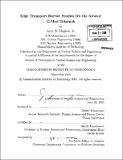| dc.contributor.advisor | Dmitri Mossessian. | en_US |
| dc.contributor.author | Hughes, Jerry W. (Jerry Wayne), 1975- | en_US |
| dc.contributor.other | Massachusetts Institute of Technology. Dept. of Nuclear Engineering. | en_US |
| dc.date.accessioned | 2006-11-07T12:09:30Z | |
| dc.date.available | 2006-11-07T12:09:30Z | |
| dc.date.copyright | 2005 | en_US |
| dc.date.issued | 2005 | en_US |
| dc.identifier.uri | http://hdl.handle.net/1721.1/34436 | |
| dc.description | Thesis (Ph. D.)--Massachusetts Institute of Technology, Dept. of Nuclear Engineering, 2005. | en_US |
| dc.description | Includes bibliographical references (p. 211-226). | en_US |
| dc.description.abstract | Edge transport barriers (ETBs) in tokamak plasmas accompany transitions from low confinement (L-mode) to high confinement (H-mode) and exhibit large density and temperature gradients in a narrow pedestal region near the last closed flux surface (LCFS). Because tokamak energy confinement depends strongly on the boundary condition imposed by the edge plasma pressure, one desires a predictive capability for the pedestal on a future tokamak. On Alcator C-Mod, significant contributions to ETB studies were made possible with edge Thomson scattering (ETS), which measures profiles of electron temperature (20 Te[eV] 800) and density (0.3 ne[1020m-3] ' 5) with 1.3-mm spatial resolution near the LCFS. Profiles of Te, ne, and Pe = neTe are fitted with a parameterized function, revealing typical pedestal widths A of 2-6mm, with ATe Ane, on average. Pedestals are examined to determine existence criteria for the enhanced D, (EDA) H-mode. A feature that distinguishes this regime is a quasi-coherent mode (QCM) near the LCFS. The presence or absence of the QCM is related to edge conditions, in particular density, temperature and safety factor q. Results are consistent with higher values of both q and collisionality v* giving the EDA regime. Further evidence suggests that increased Vpel may favor the QCM; thus EDA may have relevance to low-v* reactor regimes, should sufficient edge pressure gradient exist. | en_US |
| dc.description.abstract | (cont.) Scaling studies of pedestal parameters and plasma confinement in EDA H-modes varied operational parameters such as current Ip and L-mode target density ne,L. At fixed plasma shape, widths show little systematic variation with plasma parameters. Scalings are however determined for pedestal heights and gradients. The Pe pedestal height and gradient both scale as I, similar to scalings found on other tokamaks, though with differing pedestal-limiting physics. It is seen that the density pedestal value ne,PED scales linearly with Ip, and more weakly with h,L, indicating that neutral fueling plays a relatively limited role in setting H-mode density. Plasma stored energy scales in a linear fashion with the Pe pedestal, such that empirical confinement scalings are affected by edge pedestal scalings. Empirical determination of neutral density and ionization source was made across the pedestal region, enabling inference of neutral gradient scale length Lo and effective diffusivity Def. The Def well is comparable in width to the pedestal, and Lo tends to be less than Ane. Computation of Lo in discharges with varying ne,L yields a similar result, suggesting that A,, is generally set by the ETB extent and not neutral penetration length. Puffing gas into an existing H-mode edge yields no significant change in the values of ne,PED, Vne, which is qualitatively consistent with simulations using a coupled fluid-kinetic neutral model. Experiment and modeling indicate the importance of thermal equilibration of neutrals with ions, particularly in high density collisional) plasmas. | en_US |
| dc.description.statementofresponsibility | by Jerry W. Hugues, Jr. | en_US |
| dc.format.extent | 226 p. | en_US |
| dc.format.extent | 11597048 bytes | |
| dc.format.extent | 11606579 bytes | |
| dc.format.mimetype | application/pdf | |
| dc.format.mimetype | application/pdf | |
| dc.language.iso | eng | en_US |
| dc.publisher | Massachusetts Institute of Technology | en_US |
| dc.rights | M.I.T. theses are protected by copyright. They may be viewed from this source for any purpose, but reproduction or distribution in any format is prohibited without written permission. See provided URL for inquiries about permission. | en_US |
| dc.rights.uri | http://dspace.mit.edu/handle/1721.1/7582 | |
| dc.subject | Nuclear Engineering. | en_US |
| dc.title | Edge transport barrier studies on the Alcator C-Mod tokamak | en_US |
| dc.title.alternative | ETB studies on the Alcator C-Mod tokamak | en_US |
| dc.type | Thesis | en_US |
| dc.description.degree | Ph.D. | en_US |
| dc.contributor.department | Massachusetts Institute of Technology. Department of Nuclear Engineering | en_US |
| dc.contributor.department | Massachusetts Institute of Technology. Department of Nuclear Science and Engineering | |
| dc.identifier.oclc | 70684357 | en_US |

